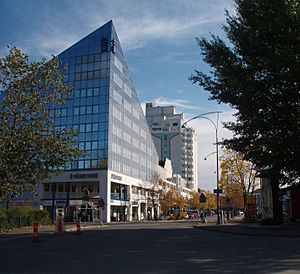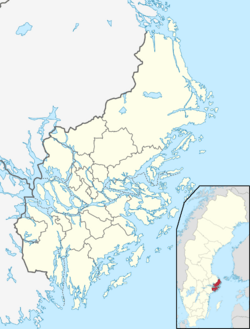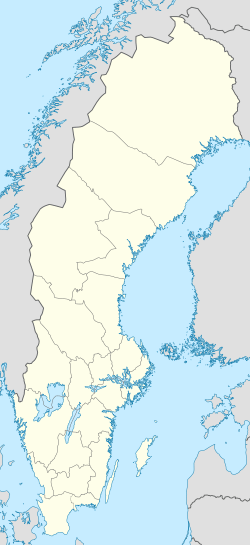Upplands Väsby facts for kids
Quick facts for kids
Upplands Väsby
|
|
|---|---|

Upplands Väsby in October 2007
|
|
| Country | Sweden |
| Province | Uppland |
| County | Stockholm County |
| Municipality | Upplands Väsby Municipality Sollentuna Municipality |
| Area | |
| • Total | 14.17 km2 (5.47 sq mi) |
| Population
(31 December 2020)
|
|
| • Total | 48,907 |
| • Density | 2,653/km2 (6,870/sq mi) |
| Time zone | UTC+1 (CET) |
| • Summer (DST) | UTC+2 (CEST) |
Upplands Väsby is a town in Sweden. It is the main town of Upplands Väsby Municipality in Stockholm County. In 2020, about 48,907 people lived there.
Contents
A Look at Upplands Väsby's Past
Upplands Väsby has a long and interesting history. People have lived here since ancient times. Scientists found a bronze axe from around 600 to 700 BC during digs near Hammarby ridge.
The land in Upplands Väsby is quite flat. Early people here lived by fishing and hunting seals and birds. They also traded a lot with other countries. Old Arabic coins found near Great Wäsby Castle show how much trade happened.
Ancient Forts and Burial Sites
You can find old hill forts at Runsa and Skavsta. These were like ancient strongholds. There are also many old burial grounds. These graves can be mounds, stone circles, or standing stones.
One famous stone circle is at Runsa. It looks like a ship and is 56 meters long. It was built around 400-500 AD. Other large burial mounds are near Löwenströmska Hospital and Runby. The biggest burial ground is at Great Wäsby Castle, with about 200 burial mounds.
How Upplands Väsby Grew
In the early 1900s, Upplands Väsby was a small community around a train station. The railway station was finished in 1865. It was on the train line between Stockholm and Uppsala.
A man named Anton Tamm owned much of the land where the town now stands. In 1903, he started the first big factory, Väsby Werkstäder. This company made things from brass and copper. Over the years, the factory changed names many times. People often called it Messingen.
Upplands Väsby Today
Today, Upplands Väsby is a modern suburban town. It is located between Stockholm and Uppsala. Stockholm city center is about 25 kilometers away. Uppsala is about 45 kilometers away.
Getting Around
It takes about 27 minutes to reach Stockholm Central Station by commuter train. You can also get to Arlanda Airport in just seven minutes by local train. This train also connects Upplands Väsby to Uppsala.
Famous People from Upplands Väsby
Many well-known music artists have lived in Upplands Väsby. These include the bands Europe, Therion, H.E.A.T., and Candlemass. Famous musicians like John Norum and Yngwie Malmsteen also lived here. Actors Shima Niavarani and Shebly Niavarani went to school in Upplands Väsby. Some famous writers, like Carl Jonas Love Almquist, also lived in the area.
Neighborhoods and Shopping
Some old factory buildings are now used for new activities. For example, the Upplands Väsby art gallery is in a former industrial building. Many old buildings have been replaced with new homes and schools.
Väsby Centrum Shopping Mall
Väsby Centrum is a large shopping mall that opened in 1972. It has been updated and expanded many times. The mall offers a wide range of stores. You can find clothes, electronics, cosmetics, books, flowers, and groceries there. There are also many restaurants.
Residential Areas
Upplands Väsby has many different neighborhoods where people live.
- Smedby/Ekebo: This area has the Viking farm yard Gunnes Gård. Many apartments here were built in the 1970s and 1980s.
- Carlslund: Located east of the E4 highway. It used to have housing for workers. New homes were built here for a housing exhibition in 1985.
- Brunnby Park: This area is in eastern Carlslund. Many villas and townhouses have been built here since 2009.
- Old Väsby or Central Väsby: This is the station area and downtown. It used to be home to the Optimus factory.
- Runby/Runby Backar: These are the northwestern parts of the municipality. They have recreation areas and Ed's church.
- Apoteksskogen (also called Sigma): This area is west of Hammarby Apotek.
- Väsbyskogen: Often considered part of Sigma.
- Sundsborg: Usually considered part of Odenslunda.
- Grimstaby: Built in the 1970s, this area looks like an old small town. It has a main street, a square, and small shops. It includes schools and kindergartens.
- Hagängen/Löwenströmska hospital: Located next to Löwenströmska hospital. It has a mix of apartment buildings and terraced houses.
- Prästgårdsmarken: This area in the southwest has mostly apartment buildings built in the 1980s.
- Bollstanäs: These southern parts have mostly villas and border Sollentuna municipality.
- Fresta
- Odenslunda
- Brunnby/Brunnby Vik: About two kilometers east of the city center, with mostly townhouses, villas, and small businesses.
- Sjukyrkoberget
- Skälby
- Sanda Ängar
Schools in Upplands Väsby
Upplands Väsby has many schools for children and teenagers. There are over 3,000 students in fourteen elementary schools and one secondary school. About half of the elementary schools are run by the community.
- Bollstanäs skola: For grades 1–5, with about 250 students.
- Breddenskolan: For grades 1–5.
- Väsbyskolan: Over 420 students, for grades 4–9. It has special classes for music and science.
- Frestaskolan: For grades 1–5, became a free school in 2008.
- Grimstaskolan: For grades 6–9, with about 450 students. This school focuses on football. It also has a special group for students with autism spectrum disorders.
- Hasselskolan: For preschool and grades 1–5.
- Odenslunda skola: For preschool and grades 1–5, became an independent school in 2008. Over 200 students attend.
- Runbyskolan: About 560 students, for preschool to grade 9.
- Smedbyskolan: For grades 1–6, with about 250 students.
- Smedsgärdsskolan: For grades 1–6, with around 1,000 students.
- Södervikskolan: For grades 6–9, became a free school in 2008, with 390 students.
- Sweden-Finnish school: A private school with about 150 students.
- Vikskolan: For preschool to grade 9, became an independent school in 2008. This school will be replaced by a new school called Viraskolan.
- Vittra in Vasby: Over 300 students, for kindergarten and grades 1–9. It is an independent school.
Secondary Schools
- Väsby new gymnasium: This school opened in August 2011. The old high school, Vilunda High School, was closed and taken down to make way for new apartments.
- ANNUAL School
- Energy School
Transportation Options
Upplands Väsby is well-connected by public transport.
- Commuter Trains:
- Stockholm commuter line 40: Travels between Uppsala C and Södertälje centrum, passing through Arlanda C, Solna, Stockholm City, Älvsjö, and Flemingsberg.
- Stockholm commuter line 41: Travels between Uppsala C (or Märsta) and Södertälje centrum, passing through Solna, Stockholm City, Älvsjö, and Flemingsberg.
- Stockholm commuter line 42X: Travels between Märsta and Nynäshamn, passing through Solna, Stockholm City, Älvsjö, and Västerhaninge.
- Bus Routes: Many bus routes serve the area, including 524, 529, 531, 532, 533, 534, 535, 536, 537, 538, 539, 545, 560, 560X, 562, 568, 577, and 684. Many of these buses start from the bus terminal at Upplands Väsby station.
- Night Bus Routes: There are also night buses, routes 592, 598, and 599.
Notable People from Upplands Väsby
- Carl Jonas Love Almqvist (1793-1866), a writer and social critic.
- Calle Asell (born 1994), an ice hockey player.
- Joey Tempest (born 1963), the lead singer of the rock band Europe.
- Robert Topala (born 1987), a video game creator, known for making Geometry Dash.
- Björn Wesström (born 1972), a football executive.
See also
 In Spanish: Upplands Väsby para niños
In Spanish: Upplands Väsby para niños
- Cederroth
- Infra City




